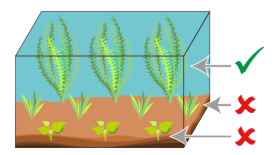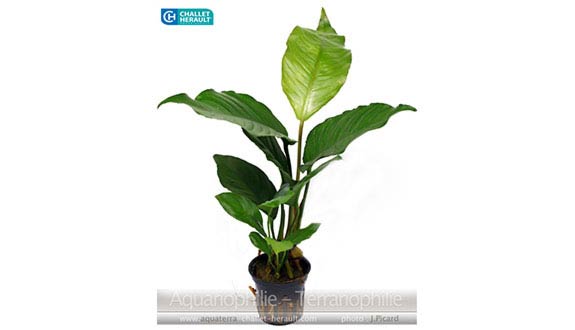

Alternative species (click on the thumbnail to see the card)
Names
Scientific name
Anubias heterophylla
Anubias congensis
Anubias engleri
Anubias bequaertii
Anubias affinis
Common name
Congo Anubias
Origin

Origin: West Africa (Congo)
Ideal fertilization

CO2: 5-40mg/l
Nitrates (NO3): 10-50mg/l
Phosphates (PO4): 0.1-3mg/l
Potassium (K): 5-30mg/l
Iron (Fe): 0.01-0.5mg/l
Group

Araceae
Kind

Rhizome
Parameters

T°: 24 to 26°C or 75 to 79°F
pH: 6 to 8
Hardness: 8 to 10°dGH
Difficulty

Average
Lighting

Low
Size

5 to 10cm (2 to 4")
Plantation

Background
Growth

Slow
Presentation
Who is the Congo Anubias?
Presentation
Who is the Congo Anubias?
Anubias du Congo is a very resistant and rather "hard" plant. Because of this, it can resist herbivorous fish such as cichlids. In the wild, it grows in streams, on roots or rocks close to the shore.
Planting and maintenance
How to plant and maintain the Congo Anubias?
Planting and maintenance
How to plant and maintain the Congo Anubias?
This Anubias is more suitable for paludariums and aquaterrariums than for freshwater aquariums. Indeed, a period of total immersion that is too long can damage your plant, or even kill it. This is especially true for an adult plant. For young shoots, this is less of a problem.
Allow plenty of space for the plant to develop and grow properly.
Be careful not to bury the rhizome of your Anubias in the substrate, otherwise it will rot.
Farming
How to farm the Congo Anubias?
Farming
How to farm the Congo Anubias?
This plant is cultivated by dividing its rhizome. Cut a piece of the mother rhizome and hang it on a root or a rock. Be careful during its development because the young shoots grow slowly and are particularly vulnerable to algae. Put your plants in the shade to prevent them from becoming overgrown with algae. If it's already too late, you can take them out of the water (don't worry, they can stand it very well) to remove the algae (which they can't stand to be out of the water for long).
Good To know
Find all additional information!
Good To know
Find all additional information!
Don't worry if your plant doesn't seem to be vegetating. It has a very slow growth, even with good conditions of maintenance, CO2 supply, substrate, nutrients... This is its normal rhythm of life!
Yours photos!
Comments
Sort by:
Please login to post comments

